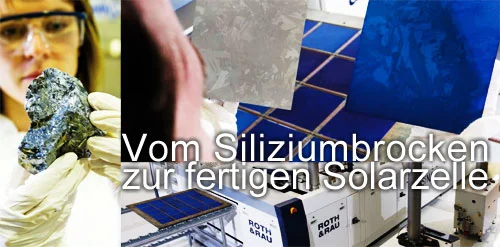Solar cells with greater efficiency: So who needs ultrapure silicon?
Adlershof is a significant location for energy research – for instance, climate friendly power generation with solar cells.
The price for photovoltaic power generation does not ultimately depend on the production costs for its solar cells. The so called wafers, the high purity silicon blanks from which the cells are made, are very expensive. “For a long time their production required silicon that was really meant for microelectronic componentry, with a minimum purity of 99.9999999%, or containing less than one foreign atom per million of silicon,” explained Fritz Kirscht, Managing Director of CaliSolar GmbH in Adlershof. Obtaining this degree of ultra purity on raw silicon, itself 99% clean, requires an extremely complex and energy intensive procedure. “Yet solar cells also work with silicon without this exceptional purity, so we can skip this special treatment.” Kirscht reported that in February, CaliSolar, with head office in California, fetched a company on board that utilises a special procedure for the low cost production of silicon with a purity of “only” 99.9999%: “When we look at the total energy balance, modules with our solar cells supply climate friendly electricity far earlier than other installations.”
In the meantime the company has managed to obtain a quality of “impure” solar cells similar to those of “pure” source materials. According to Kirscht, the usual efficiency of multicrystalline cells on the sector, for instance, is 16%. Now the next step is to simplify even further the silicon purification process. “The supporting research and development is conducted above all by our team of nearly thirty personnel here in Adlershof,” explained Kirscht. This team develops procedures that consume even less energy when extracting undesired foreign materials out of the raw silicon and that at the same time generate tailored crystals for subsequent cell production.
The Saxon company Roth & Rau, after opening its office last year in Adlershof, is also working on solar technology. It doesn’t manufacture the solar cells itself, but develops the production plant, or the “tools” so to speak of the solar sector. They are then built e.g. in China, India, Singapore, the USA, and Germany. One key technology of the company is a method for applying silicon nitride to the cells, forming on them an antireflective coating. This coating prevents incident light from being reflected at the solar cell and allows as much light as possible to pass through where it can be converted into electric power. This coating gives the normally grey solar modules their characteristic blue colour.
In Adlershof the intention is to advance above all the new product line of crystallisation, the name given to the manufacture of silicon blanks for solar cell production. “From our branch in Adlershof we can utilise our contacts in the locality to greater effect,” explained Georg Roters, Head of Product Management at Roth & Rau. “Our cooperation projects, e.g. with the Leibniz Institute for Crystal Growth (IKZ), are a crucial key to advancing our research and development work in this field.” To this end, the company also intends to open its own laboratory soon that will be optimising the production of high tech materials.
by Ralf Nestler
